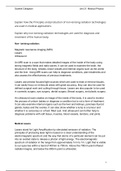Scarlett Callaghan Unit 21: Medical Physics
Explain how the Principles and production of non-ionising radiation technologies
are used in medical applications.
Explain why non-ionising radiation technologies are used for diagnosis and
treatment of the human body.
Non- ionising radiation:
Magnetic resonance imaging (MRI)
Lasers
Ultrasound
An MRI scan is a scan that makes detailed images of the inside of the body using
strong magnetic fields and radio waves. It can be used to examine the brain, the
structure of the body, breasts, blood vessels and internal organs such as the womb
and the liver. Using MRI scans can help to diagnose conditions, plan treatments and
also assess the effectiveness of previous treatments.
Lasers use precise focused light sources which are used to treat or remove tissues,
it can easily focus on miniscule areas with great accuracy, they can also be used for
defined surgical work and cutting through tissue. Lasers are also popular to be used
in cosmetic surgery, eye surgery, dental surgery, Breast surgery, and plastic surgery.
An ultrasound scan creates an image of the inside of the body, it is used to monitor
the process of unborn babies or diagnose a condition but is not a form of treatment.
It can also examine internal organs such as the liver and kidneys, pancreas thyroid
glands, testes and the ovaries. It can also show whether a lump is a tumour and
whether it is cancerous or a fluid- filled cyst. And ultrasound can further help to
diagnose problems with soft tissue, muscles, blood vessels, tendons, and joints.
Medical Lasers
Lasers stand for Light Amplification by stimulated emission of radiation. The
principles of producing laser light is based on a clear understanding of the
electromagnetic spectrum and the way that atoms of a particular element can be put
into an excited state to release a photon of light energy. The electromagnetic
spectrum of radiation in the range from approximately 1nm to 1m. Light that is visible
to our eyes lies within a band of 400nm to 700nm. Above the 700nm point infrared
radiation begins, and below the 400nm point is ultraviolet.
1






